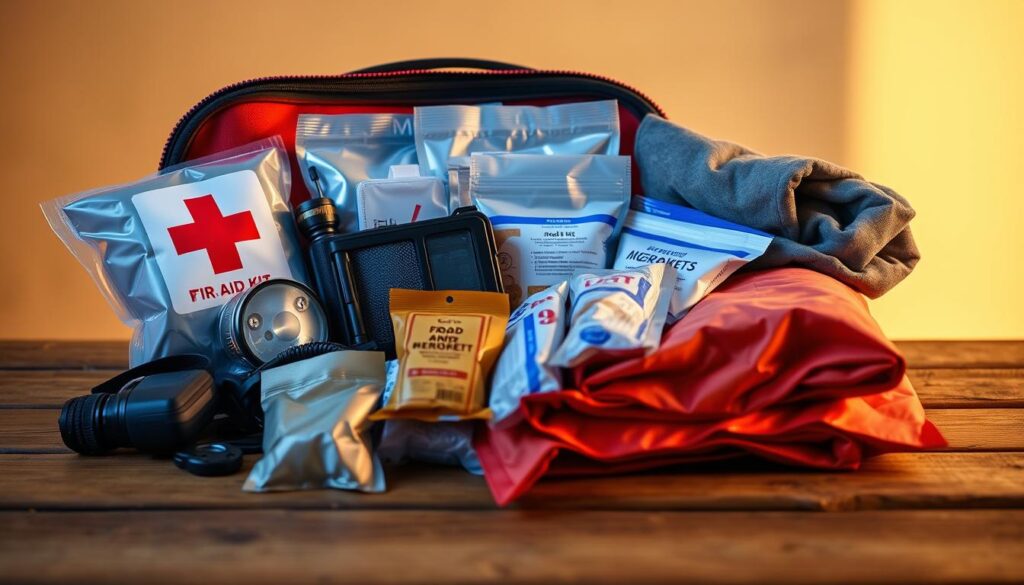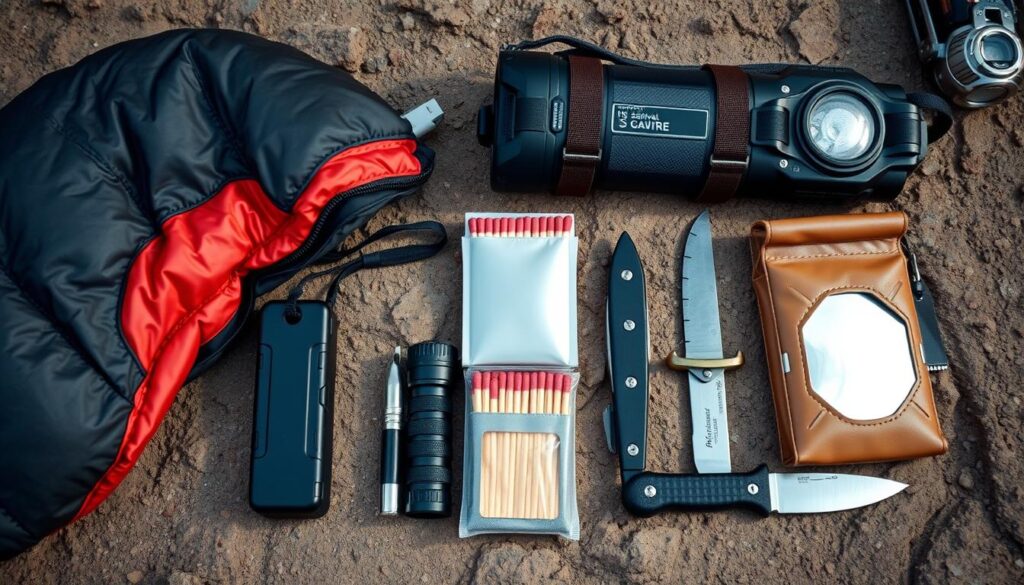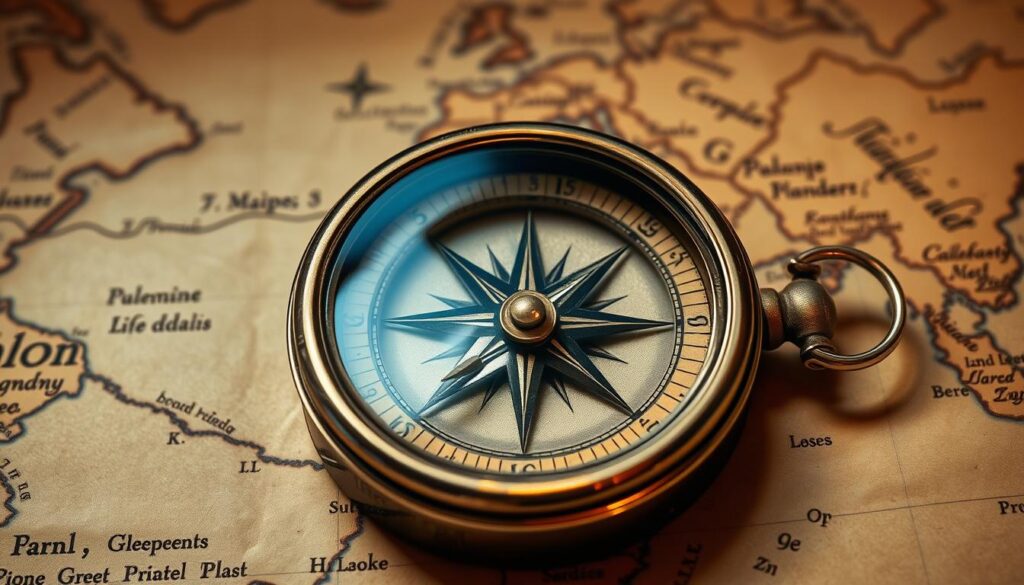I’ve learned how vital it is to be ready for the unexpected. I’m here to help you make an emergency supply kit that can be a lifesaver.
Having your own food, water, and key supplies is key for survival in emergencies. A good disaster preparedness kit means you and your family can face tough times together.
In this guide, I’ll show you how to put together a kit with all the survival gear you need. Being ready helps you handle emergencies with confidence.
Key Takeaways
- Understand the importance of having an emergency supply kit.
- Learn what essential items to include in your kit.
- Discover how to assemble your kit step-by-step.
- Gain insights into maintaining and updating your kit.
- Be prepared for any situation with the right survival gear.
Understanding the Importance of a Disaster Preparedness Kit
An emergency preparedness kit can save lives in natural disasters. You might need to survive alone for days. Having food, water, and supplies is key.
Every home needs a disaster kit. It keeps you and your family safe during emergencies. It’s more than just storing items; it’s about being ready for anything.
Why Every Household Needs One
Every home should have a disaster kit because disasters are unpredictable. A kit can protect you from harm. It should have food, water, first aid, and ways to communicate.
Types of Disasters to Prepare For
Disasters vary by region. Some areas face hurricanes, others earthquakes or floods. Knowing your risks helps you prepare your disaster preparedness checklist.
| Disaster Type | Preparation Tips | Essential Supplies |
|---|---|---|
| Hurricanes | Secure windows and doors, have a plan for evacuation. | Flashlights, batteries, non-perishable food. |
| Earthquakes | Practice earthquake drills, secure heavy furniture. | First aid kit, water, multi-tool. |
| Floods | Know your evacuation route, keep valuables elevated. | Waterproof bags, sandbags, emergency blanket. |
Knowing your disaster risks helps you prepare better. This ensures your emergency preparedness supplies are right. It keeps you and your family safe.
Essential Items for Your Disaster Preparedness Kit
Building a disaster preparedness kit is key. It must have items that keep you and your family safe during emergencies. A good kit means you’re ready for anything, giving you peace of mind and the tools to survive.
“A disaster preparedness kit is not just about stockpiling supplies; it’s about being prepared for the unexpected,” experts say. This guides what you put in your kit.
Food and Water Supplies
Having enough food and water is essential. You’ll need at least one gallon of water per person per day. This is for drinking, cooking, and staying clean. Include non-perishable foods like canned goods, dried fruits, and nuts. Don’t forget to think about your family’s dietary needs, including pets.
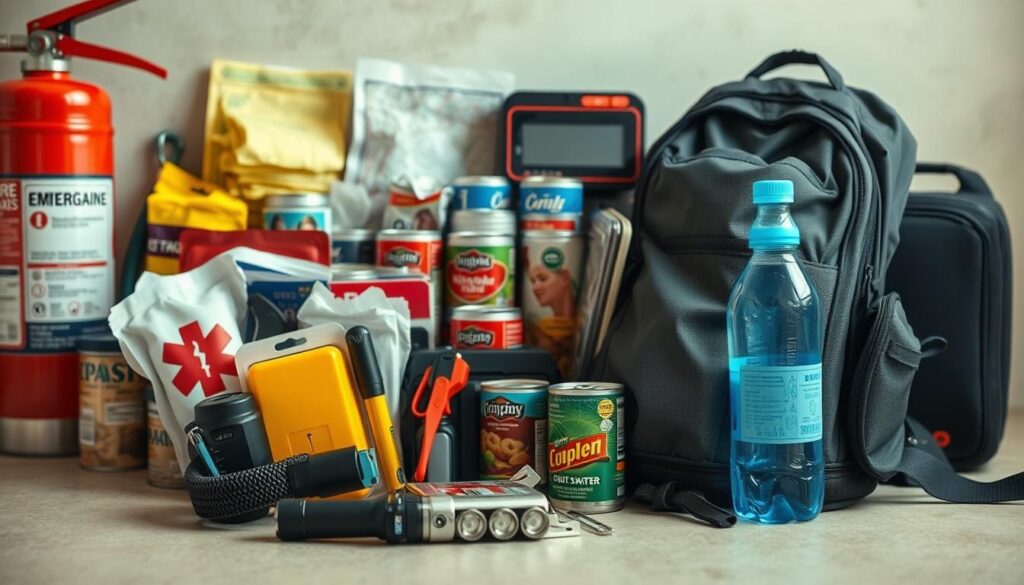
First Aid Essentials
A first aid kit is a must-have. It should have bandages, antiseptic wipes, pain relievers, and any needed prescription meds. Make sure your first aid kit is easy to find and that everyone knows where it is.
The American Red Cross advises making your first aid kit fit your family’s needs. This includes supplies for injuries and illnesses.
Personal Hygiene Products
Personal hygiene products are important but often forgotten. They help keep you and your family healthy and dignified during a disaster. Include toothbrushes, toothpaste, soap, and toilet paper. Moist towelettes, garbage bags, and hand sanitizer are also useful.
By focusing on these areas, you can make a disaster preparedness kit that really meets your family’s needs.
Tools and Equipment for My Kit
When disaster hits, having the right tools in your kit is key. The right survival gear is vital for staying safe.
My kit has tools for navigation and survival. Flashlights, batteries, multi-tools, and duct tape are must-haves.
Flashlights and Batteries
A good flashlight is essential for any emergency preparedness kit list. It helps you see in the dark, keeping you safe at home.
I look for flashlights with long battery life and durability. Having extra batteries is also a must.
- Choose a flashlight with long battery life or one that is rechargeable.
- Consider a flashlight with adjustable brightness settings.
- Store extra batteries in a dry, accessible location.
Multi-tools and Duct Tape
Multi-tools and duct tape are very useful. They’re key parts of my best emergency kit for home.
Multi-tools can cut, tighten, and open cans. Duct tape fixes things, holds items together, and can even be used as a bandage.
| Item | Purpose | Benefits |
|---|---|---|
| Multi-tool | Performs various tasks | Compact, versatile |
| Duct Tape | Repairs, secures items | Strong, adhesive |
| Flashlight | Provides light | Reliable, adjustable brightness |
With these tools in my kit, I’m ready for emergencies. They help keep my family safe.
Preparing for Specific Types of Disasters
To be truly prepared, it’s essential to consider the unique challenges posed by various types of disasters. Different regions are prone to different kinds of natural disasters. Understanding these risks is key for effective preparedness.
My disaster preparedness kit should be tailored to the specific types of disasters that could occur in my area. For instance, if I live in a hurricane-prone area, my kit will need to include supplies that can withstand strong winds and possible flooding.
Hurricane Preparedness
When preparing for hurricanes, it’s vital to have a disaster survival kit that includes:
- Non-perishable food items and a sufficient water supply
- Battery-powered lights and a radio
- First aid supplies and a manual can opener
- Personal hygiene items and a multi-tool
As noted by FEMA, “Having a plan and the necessary supplies can help you and your family stay safe during and after a hurricane.”
| Supply | Purpose |
|---|---|
| Water | Hydration and hygiene |
| Non-perishable food | Nourishment during prolonged storms |
| Flashlights | Lighting during power outages |
Earthquake Preparedness
For earthquake preparedness, my emergency preparedness supplies should include:
- Secured heavy furniture and objects to prevent them from falling
- A whistle to signal for help if trapped
- Dust masks to help filter the air
- A plan for evacuation or shelter-in-place
As the American Red Cross suggests, “Practicing earthquake drills can help you and your family know what to do when an earthquake strikes.”

Flood Preparedness
Flood preparedness requires a different set of considerations, including:
- Knowing the flood risk in my area and having an evacuation plan
- Keeping disaster preparedness kit supplies in a waterproof container
- Avoiding walking or driving through floodwaters
- Having a plan for safely shutting off utilities
By understanding the specific risks associated with different types of disasters and tailoring my preparations, I can significantly enhance my resilience to these events.
Tailoring My Kit for Family Needs
When I prepare my disaster kit, I think about what my family needs. A good kit meets the needs of everyone, including kids and pets.
I need to pick the emergency kit essentials for my family. This means thinking about everyone’s age, health, and special needs.
Special Considerations for Children
Children have their own needs for a disaster kit. I must include diapers, formula, and fun things to keep them busy.
I also need to pack any medicines my kids take. A first aid kit for kids is a must. Plus, a comfort item like a favorite toy helps them feel better during emergencies.
| Item | Quantity | Notes |
|---|---|---|
| Diapers | 1-2 weeks’ supply | Consider the age and size of my children |
| Formula | 1-2 weeks’ supply | Check expiration dates regularly |
| Child-friendly entertainment | Variety pack | Include books, games, and other activities |
Including Pets in the Planning
Pets are part of our family, so we must plan for them too. I need to pack food, water, and any medicines they need.
It’s also important to have a pet carrier or crate. A leash and collar are also needed to keep pets safe. For more tips on emergency kits, I can check FEMA’s website.
How to Store and Maintain My Disaster Kit
Having a good disaster plan is not just about gathering supplies. It’s also about how you store and keep them. A well-organized kit means you can find what you need fast when disaster hits.
There are two key parts to this: the right storage and regular checks. Proper storage keeps supplies in good shape. I keep my kit in a spot that’s easy to get to and known by everyone. This spot is usually a basement or closet, away from sunlight and moisture.
Best Storage Practices
For storing emergency supplies, I stick to a few rules. First, I use airtight containers to keep out dust, moisture, and pests. For example, I store food in sealed bins or Mylar bags to keep it fresh.
Keeping the kit tidy is also key. I use clear labeling and sort items by type, like first aid, food, and tools. This makes it simple to find what I need fast.
Checking Expiration Dates
It’s important to check the expiration dates of my kit’s supplies regularly. I review the kit every six months to make sure everything is good to go. This includes checking food, water purification tablets, and any meds.
As
“The best preparation is not just having a kit, but ensuring it’s maintained and ready for when you need it.”
, I always keep this in mind when preparing for disasters.
By sticking to these practices and keeping up with maintenance, I know my emergency kit is ready for any disaster.
Creating a Family Communication Plan
Creating a family communication plan is key for emergency readiness. It makes sure everyone can reach each other and meet up in emergencies. This reduces stress and uncertainty.
Importance of Communication in Emergencies
Good communication is essential in emergencies. It helps family members check on each other and make smart choices. A solid plan includes important contact info and how to stay in touch.
Key elements of a family communication plan include:
- Identifying emergency contact numbers
- Designating a meeting point
- Establishing a communication protocol
Designating a Meeting Point
Picking a safe meeting spot is vital. It could be a park, a neighbor’s house, or a spot outside the neighborhood. The goal is to pick a place that’s easy to get to and remember.
For more help on making a family emergency plan, check out the FEMA document. It has detailed instructions and templates.
| Meeting Point Characteristics | Ideal Location |
|---|---|
| Accessibility | Near home or neighborhood landmark |
| Safety | Avoid areas prone to hazards |
| Recognizability | Easy to find and remember |
Resources for Disaster Preparedness
To be ready for disasters, knowing where to find reliable resources is key. Having a disaster preparedness kit is just the start. It’s also important to know where to get more info and support.
The Federal Emergency Management Agency (FEMA) is a top source for disaster prep in the U.S. They offer guides on making a disaster preparedness checklist, info on emergency preparedness supplies, and safety tips for different disasters.
FEMA Resources
FEMA’s website is full of useful info on disaster prep. They have guides for various disasters like hurricanes, earthquakes, and floods. They also have tips on making a family emergency plan and stocking up on survival gear and emergency supplies.
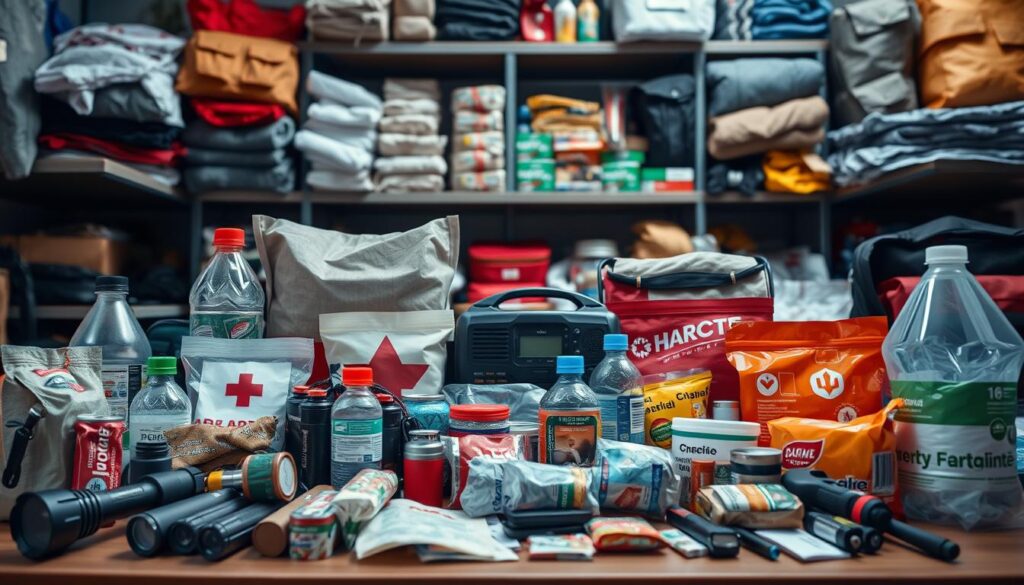
Local Emergency Management Agencies
Local emergency management agencies are also key for disaster prep. They give info specific to your area, like evacuation routes and emergency shelters. They might also offer workshops on disaster prep and response. Using FEMA and local agency resources together helps you understand how to prepare for and respond to disasters in your area.
By using these resources, I can improve my disaster prep and be ready for emergencies.
Taking Steps Beyond the Kit
Being ready for disasters is more than just having an emergency kit. It’s about being part of a community effort and learning new skills. Having the right emergency kit essentials is just the start.
“Disaster preparedness is not just about individual readiness, but also about community resilience,” as emphasized by FEMA. This quote highlights the need to look beyond our own disaster survival kits to strengthen our communities.
Community Preparedness
Getting involved in community preparedness is key to making our communities stronger. This means joining local emergency planning, volunteering for disaster response, and teaching neighbors about preparedness.
- Participate in neighborhood emergency planning meetings.
- Volunteer with local disaster response organizations.
- Educate your neighbors on disaster preparedness.
Skills to Learn for Emergencies
Learning skills to learn for emergencies is also essential. This includes first aid, CPR, and knowing how to use your emergency preparedness kit items.
- Take a first aid course to learn basic medical skills.
- Learn CPR to help save lives during cardiac emergencies.
- Practice using the tools and equipment in your kit.
By focusing on community preparedness and learning new skills, we can better face emergencies. This all-encompassing approach is vital for a more resilient community.
Regularly Updating My Disaster Preparedness Kit
To keep my disaster preparedness kit effective, I must update it often. I check its contents, refresh supplies, and make sure it fits my family’s needs.
Knowing when to refresh my disaster preparedness kit is key. If items have expired or been used, it’s time for an update.
Signs That It's Time to Refresh My Kit
There are clear signs my kit needs an update. These include:
- Expired food or medical supplies
- Used or depleted supplies
- Changes in family needs, such as new members or health changes
Staying alert to these signs helps me keep my kit current and useful.
How Often Should I Review My Kit
I should review my emergency preparedness supplies at least twice a year. This keeps my kit effective and relevant.
| Review Frequency | Purpose |
|---|---|
| Every 6 months | Check expiration dates, update supplies, and ensure the kit meets current family needs |
| After a disaster or emergency | Restock used supplies and assess the kit’s effectiveness during the event |
Regularly reviewing and updating my disaster preparedness kit makes it the best emergency kit for home. It’s ready to support my family in emergencies.
Educating My Family About the Kit
Preparing my family for a disaster is more than just having a kit. It’s about education and practice. It’s key that everyone knows what’s in the kit and why it’s important.
Having the right supplies is just the start. It’s also about knowing how to use them. Teach your family about the kit’s contents, where it is, and how to use it in emergencies.
What to Teach Children
Teaching kids about the kit should match their age and level of understanding. Young kids need simple explanations and drills. Older kids can learn more, like first aid or using flashlights.
Key Points to Teach Children:
- The location of the emergency kit
- The importance of staying calm during emergencies
- Basic first aid techniques
- How to communicate with family members if separated
Drills and Practice Scenarios
Regular drills are key to making sure everyone knows what to do. Practice evacuating, finding a meeting spot, and using kit items.
Example Drill Scenarios:
| Scenario | Objective |
|---|---|
| Simulated power outage | Practice using flashlights and battery-powered radios |
| Mock evacuation | Ensure all family members know the evacuation route and meeting point |
| First aid simulation | Practice using first aid supplies for minor injuries |
By teaching my family about the kit and doing drills, we’re all ready for emergencies together.
Final Thoughts on Disaster Preparedness
Looking back, I see that a disaster survival kit is just the start. It’s about making my family and community ready and strong.
Building Resilience
Making an emergency kit takes planning, but it’s key for my family’s safety. With the right gear, we can face emergencies better.
It’s important to encourage others to prepare too. By sharing what I’ve learned, I help build a community ready for disasters.
Sharing Knowledge
I’ll keep working on my kit and sharing what I know. Together, we can make our community stronger, one kit at a time.
FAQ
What is a disaster preparedness kit, and why do I need one?
A disaster preparedness kit is a set of essential items for survival during emergencies. It helps you and your family until help arrives or the disaster ends. Having one ensures you’re ready for any situation.
What are the essential items to include in my disaster preparedness kit?
Your kit should have food, water, first aid, and hygiene products. Don’t forget flashlights, batteries, multi-tools, and duct tape. Include items like diapers, formula, and pet supplies for your family’s needs.
How often should I check and update my disaster preparedness kit?
Check and update your kit twice a year or when your family changes, like having a new baby. Always check expiration dates and replace food, water, and medical supplies as needed.
What kind of food and water supplies should I include in my kit?
Include non-perishable foods like canned goods and dried fruits. Have at least one gallon of water per person per day. A water filtration system or purification tablets are also good to have.
How can I tailor my disaster preparedness kit to meet the specific needs of my family?
Customize your kit for your family’s needs. Add items like diapers, formula, and pet food. Include any medical equipment or supplies your family might need.
What are some resources available to help me with disaster preparedness?
FEMA, local emergency agencies, and online guides can help. Also, talk to your local American Red Cross chapter or disaster relief organizations.
How can I ensure that my family knows what to do in case of a disaster?
Create a family communication plan and choose a meeting point. Practice drills and teach your family about your kit and its uses.
What are some signs that it’s time to refresh my disaster preparedness kit?
Refresh your kit if food or medical supplies expire or are spoiled. Also, update it after any damage or changes in your family, like a new baby.
How can I store my disaster preparedness kit?
Store your kit in a cool, dry place like a basement. Keep a smaller kit in your car or at work for easy access.
What are some skills I should learn to be better prepared for emergencies?
Learn first aid, CPR, and emergency response. Take courses or workshops on disaster preparedness and response.

